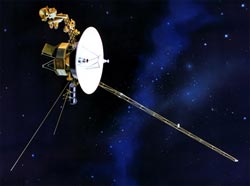Voyager 1 has entered a new region of space, sudden changes in cosmic rays indicate

The spacecraft Voyager 1 appears to have left the heliosphere, according to a new study. (Credit: NASA)<br>
The heliosphere is a region of space dominated by the Sun and its wind of energetic particles, and which is thought to be enclosed, bubble-like, in the surrounding interstellar medium of gas and dust that pervades the Milky Way galaxy.
On August 25, 2012, NASA's Voyager 1 spacecraft measured drastic changes in radiation levels, more than 11 billion miles from the Sun. Anomalous cosmic rays, which are cosmic rays trapped in the outer heliosphere, all but vanished, dropping to less than 1 percent of previous amounts. At the same time, galactic cosmic rays – cosmic radiation from outside of the solar system – spiked to levels not seen since Voyager's launch, with intensities as much as twice previous levels.
The findings have been accepted for publication in Geophysical Research Letters, a journal of the American Geophysical Union.
“Within just a few days, the heliospheric intensity of trapped radiation decreased, and the cosmic ray intensity went up as you would expect if it exited the heliosphere,” said Bill Webber, professor emeritus of astronomy at New Mexico State University in Las Cruces. He calls this transition boundary the “heliocliff.”
In the GRL article, the authors state: “It appears that [Voyager 1] has exited the main solar modulation region, revealing [hydrogen] and [helium] spectra characteristic of those to be expected in the local interstellar medium.”
However, Webber notes, scientists are continuing to debate whether Voyager 1 has reached interstellar space or entered a separate, undefined region beyond the solar system.
“It's outside the normal heliosphere, I would say that,” Webber said. “We're in a new region. And everything we're measuring is different and exciting.”
The work was funded by NASA's Jet Propulsion Laboratory in Pasadena, Calif.
Notes for Journalists
Journalists and members of the public can download a PDF copy of this accepted article by clicking on this link: http://onlinelibrary.wiley.com/doi/10.1002/grl.50383/abstract
Or, you may order a copy of the final paper by emailing your request to Peter Weiss at pweiss@agu.org. Please provide your name, the name of your publication, and your phone number.
Neither the paper nor this press release are under embargo
Title:
“Recent Voyager 1 Data Indicate that on August 25, 2012 at a Distance of 121.7 AU From the Sun, Sudden and Unprecedented Intensity Changes were Observed in Anomalous and Galactic Cosmic Rays”
Authors:
W.R. Webber New Mexico State University, Department of Astronomy, Las Cruces, New Mexico, USA;F.B. McDonald University of Maryland, Institute of Physical Science and Technology, College Park, Maryland, USA. (Deceased)
Contact information for the authors:
W.R. Webber, Email: bwebber@nmsu.edu, Telephone: (575) 646-2007
Media Contact
More Information:
http://www.agu.orgAll latest news from the category: Earth Sciences
Earth Sciences (also referred to as Geosciences), which deals with basic issues surrounding our planet, plays a vital role in the area of energy and raw materials supply.
Earth Sciences comprises subjects such as geology, geography, geological informatics, paleontology, mineralogy, petrography, crystallography, geophysics, geodesy, glaciology, cartography, photogrammetry, meteorology and seismology, early-warning systems, earthquake research and polar research.
Newest articles

Superradiant atoms could push the boundaries of how precisely time can be measured
Superradiant atoms can help us measure time more precisely than ever. In a new study, researchers from the University of Copenhagen present a new method for measuring the time interval,…

Ion thermoelectric conversion devices for near room temperature
The electrode sheet of the thermoelectric device consists of ionic hydrogel, which is sandwiched between the electrodes to form, and the Prussian blue on the electrode undergoes a redox reaction…

Zap Energy achieves 37-million-degree temperatures in a compact device
New publication reports record electron temperatures for a small-scale, sheared-flow-stabilized Z-pinch fusion device. In the nine decades since humans first produced fusion reactions, only a few fusion technologies have demonstrated…





















